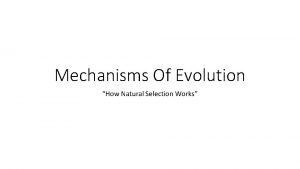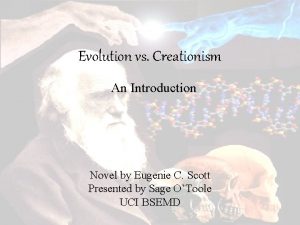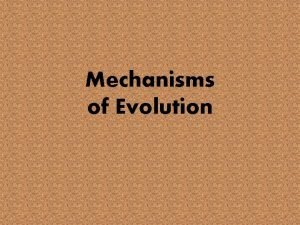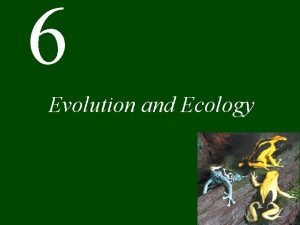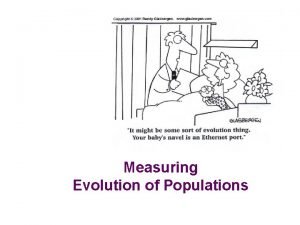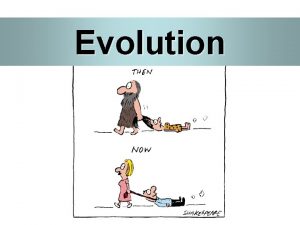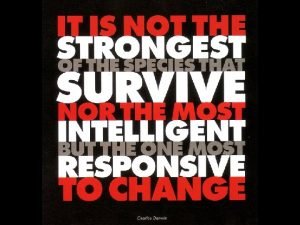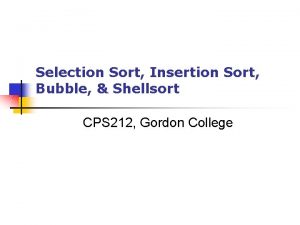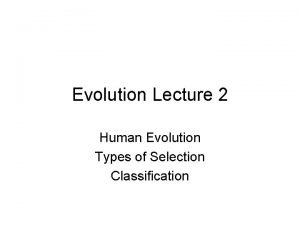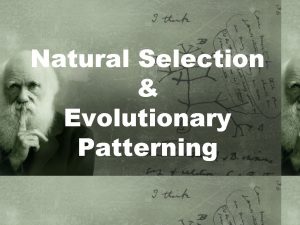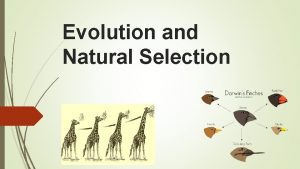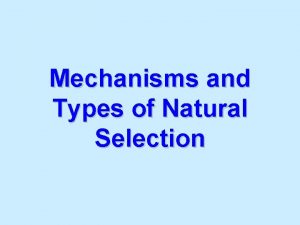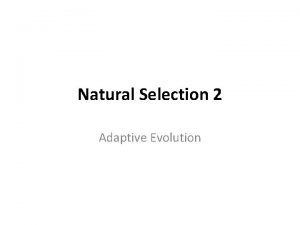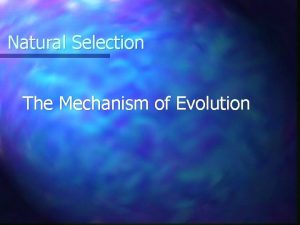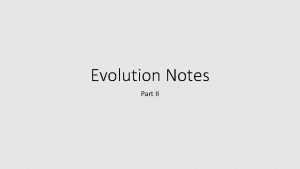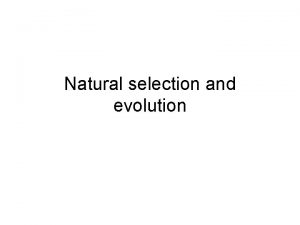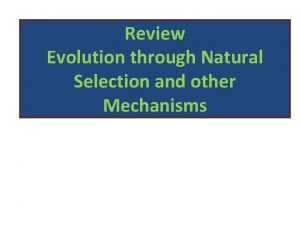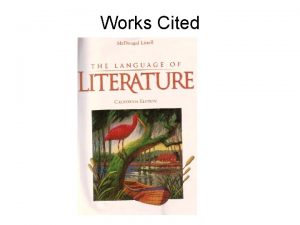Mechanisms Of Evolution How Natural Selection Works Review





















- Slides: 21

Mechanisms Of Evolution “How Natural Selection Works”

Review Carbohydrate, Protein, Lipid or Amino acid…. . carbohydrate Protein

Review Carbohydrate, Protein, Amino acid or lipid Amino acid (Nucleic acid)

Review Nucleic Acid (contains nitrogen and has R groups) Carbohydrate (a ring and contains nitrogen) Protein (No Nitrogen)

Model REVIEW Miller & Urey Redi Organic Molecules Pasteur

Macromolecules review Lipid Protein Carbohydrate Amino Acid

O Cerrebellum P T F Medulla Oblongata

P O T Partial Lobe F Frontal Lobe Temporal Lobe Occipital Lobe

Mechanisms of Evolution 1. How did natural selection cause changes in the island beetle population after the drought? 2. How does genetic drift affect allele frequency? 3. How does gene flow affect the beetle population?

Natural Selection Natural selection is affected by: Inherited Variations Reproductive of Alleles success Survival of the fittest • Genes passed on • Organisms that • Variations of by parents survive to traits that are • Allele frequencies reproduce favorable to that are favorable • Overproduction survive to environment of offspring = environment more competition • Drastic changes for resources to environment leads to best fitted to live Speciation • New species • Isolation of populations

Mechanisms of Evolution Mechanisms that change populations over time are: Genetic Drift Gene Flow Nonrandom Mating • Random changes in • Allele frequency • Sexual selection allele frequency changes due genes • Sexual mating (pairs) • Bottleneck effect moving in or out of • Females select mate changes in allele population based on size, frequency reduction • Immigration – bring strength or in size of population new genes coloration • Founder effect allele • Emigration – remove frequency due to genes migration

• SC. 912. L. 15. 13 • A group of well‐separated islands in the Pacific Ocean has a population of hibiscus plants that produce either orange or white flowers. On one of the islands, most of the hibiscus plants were killed a few years ago by a volcanic lava flow. • Why is there a greater percentage of orange hibiscus plants on this island than on the other islands? • A. Cross pollination across the islands without the lava flow caused the percentage of orange flowers to dramatically • change on these islands over time. • B. The hibiscus plants on the island that had the lava flow suffered from a higher mutation rate than plants on other islands, causing a difference in the populations. • C. The limited population size after the lava flow resulted in a limited gene pool, causing genetic drift in future generations of hibiscus plants on this island. • D. Orange flowering hibiscus plants were better adapted to survive lava flows, so white hibiscus were naturally selected out of the population on the island.

Water frogs that live on Greek islands in the Mediterranean were separated from mainland water frogs when salt‐water levels rose to form the islands, allowing differences in the isolated populations to develop. Suppose one large group of frogs on the mainland uses a low‐pitched call to attract mates while otherwise identical frogs on a nearby island use a high‐pitched call. A boat carries a few high‐pitched frogs in its cargo to the mainland. Which of the following answer choices best predicts the outcome of this event? • A. The frogs from the islands introduce new genes to the mainland gene pool, causing a change of pitch in the mainland frog population. • B. The mainland frogs respond to competition with the new frogs by genetically mutating their offspring to produce high‐‐‐pitched calls.

Suppose a family of black wolves migrates across a land bridge to a region supporting a large population of gray wolves. A few generations later, the population consists entirely of wolves with black and gray markings. • Which of the following best describes the mechanism that caused this change in the population of the wolves in the region? A. Genetic mutations naturally occurred in the black and gray wolf populations, resulting in both groups simultaneously developing black and gray coat markings. B. The flow of black wolf genes across the land bridge added to the gray wolf population's gene pool, increasing the frequency of the genes for black fur in the population.

• Genetic drift states that the random effects of everyday life can cause differences in the survival and reproduction of individuals. What is one effect of genetic drift on evolution? • A. It produces only the traits in a population that are best adapted to the environment. • B. It can cause an unusual amount of genetic variation within a single population of a species. • C. It can cause a population’s allele frequencies to become those predicted by the Hardy‐Weinberg principle. • D. It can cause certain traits in a population to increase even if those traits are not the ones that are best adapted to the environment.

Gene flow is one force that can cause evolutionary change. Which example best illustrates gene flow? A. A flock of migrating geese enters into the territory of another flock and begins interbreeding. B. A flock of geese becomes isolated on an island, and over time, the population begins to exhibit new characteristics. C. Some individuals in a flock of geese have genes that are more advantageous, and over time, the numbers of these geese increase. D. A flock of migrating geese loses its way to its wintering grounds, leaving other geese without competition for resources and enabling those geese to produce more offspring.

2. A small population of chimpanzees lives in a habitat that undergoes no changes for a long period. How will genetic drift probably affect this population? • A. It will accelerate the appearance of new traits. • B. It will promote the survival of chimpanzees with beneficial traits. • C. It will increase the number of alleles for specific traits. • D. It will reduce genetic diversity. W. A. R.

Speciation is the formation of new species as a result of evolution by natural selection. What effect could separation of populations have on speciation? • A. One half of the species will go extinct if the population is separated. • B. The separated populations will always evolve into at least two different species. • C. If the environments differ enough, the separated populations may evolve differently. • D. By separating, the populations will no longer be able to interbreed and will die off.

The use of pesticides on crops has been a common farming practice for decades. What has been the greatest effect of natural selection through the use of pesticides on certain insect populations? • A. Natural selection has been altered because the insects and their predators are killed. • B. The rate of selection is increased because the pesticides do not kill the insects that are naturally resistant to it. • C. The rate of selection has decreased because the pesticides kill only young insects. • D. The pesticides have altered natural selection by causing the insect DNA to spontaneously mutate.

• A large population of cockroaches was sprayed with an insecticide. A few of the cockroaches survived and produced a population of cockroaches that was resistant to this spray. What can best be inferred from this example? • A. A species will adapt no matter what the environment. • B. The environment has no effect on the survival of an organism. • C. Insecticides cause mutations that are passed on to the next generation. • D. Individuals with favorable variations survive and reproduce.

 Types of natural selection in evolution
Types of natural selection in evolution Mechanisms evolution
Mechanisms evolution Natural selection vs evolution
Natural selection vs evolution What is evolution and natural selection
What is evolution and natural selection Similarities
Similarities Natural selection vs artificial selection
Natural selection vs artificial selection Artificial selection vs natural selection
Artificial selection vs natural selection Disruptive selection.
Disruptive selection. Natural selection vs artificial selection
Natural selection vs artificial selection Mechanisms of evolution
Mechanisms of evolution Mechanism of evolution
Mechanism of evolution Mechanism of evolution
Mechanism of evolution Mechanisms of evolution
Mechanisms of evolution Mechanisms of evolution
Mechanisms of evolution Evolution graphic organizer
Evolution graphic organizer Shaping evolutionary theory
Shaping evolutionary theory Safety at street works and road works
Safety at street works and road works Difference between insertion sort and bubble sort
Difference between insertion sort and bubble sort Evolution types
Evolution types Amari natural gradient
Amari natural gradient Balancing selection vs stabilizing selection
Balancing selection vs stabilizing selection K selected
K selected

